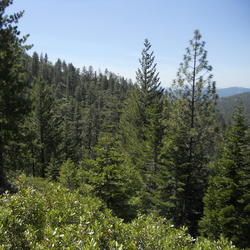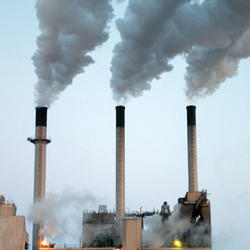The use of carbon dioxide (CO2) injection for enhanced oil recovery (EOR) can prolong the productivity of many oil reservoirs and increase the U.S. hydrocarbon recoverable resource volume.
Geologic Carbon Dioxide and Energy-related Storage, Gas Resources, and Utilization
Caballos Novaculite Reservoir Outcrop
A major reservoir for naturally occurring carbon dioxide in southwestern Texas
Atop the LaBarge Platform
A major reservoir for naturally occurring carbon dioxide, helium, and hydrocarbon gases
Mud Volcanoes
Mud volcanoes at the Davis-Schrimpf Seep Field, Calipatria, California
Above-ground Infrastructure for Storing Excess Energy
Subsurface natural gas storage in the Hutchinson Salt Member in Reno County, Kansas
The objectives of this task are to conduct relevant research needed to 1) evaluate helium (He) and CO2 resources; 2) support future assessments of low-thermal gases and better understand their resources and potential for use as analogues for anthropogenic CO2 storage; 3) study the feasibility of large-scale CO2 mineralization in the United States; 4) develop pressure-limited dynamic models for regional CO2 storage assessments and economic evaluations; and 5) evaluate geologic energy storage resources.
Geologic Carbon Dioxide Utilization Topics
Utilization of other energy-related gases such as CO2, He, nitrogen (N2), and hydrogen sulfide (H2S), if separated and concentrated from the produced natural gas stream, can make otherwise low-thermal (un-economic) natural gas accumulations a viable part of the national natural gas resource base. Many of these gases, including CO2, are separated and vented at the production site (H2S is typically reinjected), thereby contributing greenhouse gas to the atmosphere. Similarly, methane emissions during coal mining and after mine closure are often released to the atmosphere and contribute to greenhouse gases instead of being captured and utilized for energy production. The national electrical grid requires a balance between supply and demand across daily to annual cycles. Subsurface energy storage mechanisms including compressed air or gas, pumped hydroelectric, and geothermal require additional geologic investigations and assessments of available storage resources. To address an all-of-the-above approach, this project works to build improved geologic models needed to describe the distribution and resource-potential of these various energy options.
This task plans to complete a national assessment of He and CO2 resources found in natural gas reservoirs. New field and natural gas geochemistry data collected by task staff will be compiled and interpreted for scientific journal publications. Models of natural CO2 leakage of stored CO2 into shallow aquifers will be developed. A report describing the feasibility of large-scale CO2 mineralization in the United States was completed in 2019. In addition, engineering and economic modeling will be used to better characterize pressure-limited geologic CO2 storage resources. The task will evaluate the datasets and key process steps required to build a probabilistic assessment methodology to assess various geologic subsurface energy storage options that are available for use by the U.S. energy industry.
Subtasks:
- National Helium Resource Assessment: 01-OCT-2017 to 30-SEP-2022 -- Brennan
- Natural CO2 and Helium - Resources and Analogues for Anthropogenic CO2 Storage: 01-OCT-2017 to 30-SEP-2022 -- Brennan
- Feasibility of CO2 Mineralization in the United States: 01-OCT-2017 to 30-SEP-2022 -- Blondes
- Economics of CO2 storage: 01-OCT-2017 to 30-SEP-2020 -- Anderson, Freeman
- Geologic Energy Storage: 01-OCT-2019 to 30-SEP-2022 -- Buursink
Slideshows Associated with Project Member Talks:
- Federal lands greenhouse gas emissions and sequestration – a modified EPA methodology [.pdf]
- A Pressure-limited Model to Estimate CO2 Injection and Storage Capacity of Saline Formations: Investigating the Effects of Formation Properties, Model Variables and Presence of Hydrocarbon Reservoirs [.pdf] [1.2 MB]
- Overview of USGS Carbon Sequestration - Geologic Research and Assessments Project [.pdf] [2.1 MB]
- Status Report: Estimating greenhouse gas emissions from fossil fuels produced from Federal lands [.pdf] [1.2 MB]
- U.S. Geological Survey National Assessment of Geologic Carbon Dioxide Storage Resources and Associated Research [.pdf] [2.3 MB]
- U.S. Geological Survey National Assessment of Geologic Carbon Dioxide Storage Resources and Associated Research [.pdf] [2.6 MB]
- National Assessment of Geologic Carbon Dioxide Storage Resources - Results [.pdf] [2.2 MB]
- U.S. Geological Survey Geologic Carbon Dioxide Storage Resource Assessment of the United States - 2012 Project Update [.pdf] [3.9 MB]
- Examining Salinity Restrictions for CO2 Storage: Suggestions from Basin to Reservoir Scales [.pdf] [1.9 MB]
- Using ArcGIS to Identify Environmental Risk Factors Associated with CO2 Storage [.pdf] [1.7 MB]
- A Probabilistic Assessment Methodology for the Evaluation of Geologic Carbon Dioxide Storage [.pdf] [1.4 MB]
- CO2 Fluid Flow Modeling to Derive the Time Scales of Lateral Fluid Migration [.pdf] [1.2 MB]
- U.S. Geological Survey Geologic Carbon Dioxide Storage Resource Assessment of the United States - Project Update [.pdf] [3.3 MB]
Below are other science projects associated with this project task.
Carbon and Energy Storage, Emissions and Economics (CESEE)
Economics of Energy Transitions
Geologic Energy Storage
Assessing Emissions from Active and Abandoned Coal Mines
Induced Seismicity Associated with Carbon Dioxide Geologic Storage
Methodology Development and Assessment of National Carbon Dioxide Enhanced Oil Recovery and Associated Carbon Dioxide Storage Potential
Below are data or web applications associated with this project task.
Carbon Dioxide Storage Resources-Anadarko and Southern Oklahoma Basins: Chapter R. Spatial Data
Carbon Dioxide Storage Resources - Appalachian Basin, Black Warrior Basin, Illinois Basin, and Michigan Basin: Chapter P, Spatial Data
Carbon Dioxide Storage Resources-Wind River Basin: Chapter O, Spatial Data
Optimization simulations to estimate maximum brine injection rates in the Illinois Basin
Geologic formations and mine locations for potential CO2 mineralization
Dataset of Helium Concentrations in United States Wells
Model of groundwater flow, gas migration, and reactive transport in the Virgin River Basin, SW Utah
Geospatial Data for a Preliminary GIS Representation of Deep Coal Areas for Carbon Dioxide Storage in the Contiguous United States and Alaska
Federal Lands Greenhouse Gas Emissions and Sequestration in the United States: Estimates 2005-14 - Data Release
Mercury injection capillary pressure data in the U.S. Gulf Coast Tuscaloosa Group in Mississippi and Louisiana collected 2015 to 2017
Microbiology of the greater Bravo Dome region
Below are multimedia items associated with this project task.
The use of carbon dioxide (CO2) injection for enhanced oil recovery (EOR) can prolong the productivity of many oil reservoirs and increase the U.S. hydrocarbon recoverable resource volume.
Below are publications associated with this project task.
Geologic carbon management options for the North Atlantic-Appalachian Region
Assessing global geologic carbon dioxide storage resources
Dynamic estimates of geologic CO2 storage resources in the Illinois Basin constrained by reinjectivity of brine extracted for pressure management
Possible effects of multiphase methane evolution during a glacial cycle on underpressure development in sedimentary basins: An analysis with application to the northeast Michigan Basin
National assessment of helium resources within known natural gas reservoirs
Assessing gas leakage potential into coal mines from shale gas well failures: Inference from field determination of strata permeability responses to longwall-induced deformations
Potential Pb+2 mobilization, transport, and sequestration in shallow aquifers impacted by multiphase CO2 leakage: A natural analogue study from the Virgin River Basin in Southwest Utah
Computational methodology to analyze the effect of mass transfer rate on attenuation of leaked carbon dioxide in shallow aquifers
Estimating the net costs of brine production and disposal to expand pressure-limited dynamic capacity for basin-scale CO2 storage in a saline formation
Modeling geologic sequestration of carbon dioxide in a deep saline carbonate reservoir with TOUGH2–ChemPlugin, a new tool for reactive transport modeling
Compositional analysis of formation water geochemistry and microbiology of commercial and carbon dioxide-rich wells in the southwestern United States
Methodology for estimating the prospective CO2 storage resource of residual oil zones at the national and regional scale
Below are data or web applications associated with this project task.
Federal Lands Emissions and Sequestration in the United States: Estimates 2005-14
This website is a data visualization companion to the U.S. Geological Survey (USGS) report titled Federal Lands Greenhouse Gas Emissions and Sequestration in the United States: Estimates 2005-14. The maps and charts on this site include the estimated emissions and sequestration from both fossil fuel activities and ecosystem processes on Federal lands only.
Geologic Carbon Dioxide Sequestration Interactive Map
The Geologic CO2 Sequestration interactive web map includes investigated basins, assessed areas, stratigraphic columns, and well density information.
Below are news stories associated with this project task.
Below are FAQ associated with this project task.
How does carbon get into the atmosphere?
Atmospheric carbon dioxide comes from two primary sources—natural and human activities. Natural sources of carbon dioxide include most animals, which exhale carbon dioxide as a waste product. Human activities that lead to carbon dioxide emissions come primarily from energy production, including burning coal, oil, or natural gas. Learn more: Sources of Greenhouse Gas Emissions (EPA)
Has the USGS made any Biologic Carbon Sequestration assessments?
The USGS is congressionally mandated (2007 Energy Independence and Security Act) to conduct a comprehensive national assessment of storage and flux (flow) of carbon and the fluxes of other greenhouse gases (including carbon dioxide) in ecosystems. At this writing, reports have been completed for Alaska , the Eastern U.S. , the Great Plains , and the Western U.S. Learn more: Land Change Science...
How much carbon dioxide does the United States and the World emit each year from energy sources?
The U.S. Energy Information Administration estimates that in 2019, the United States emitted 5,130 million metric tons of energy-related carbon dioxide, while the global emissions of energy-related carbon dioxide totaled 33,621.5 million metric tons.
Which area is the best for geologic carbon sequestration?
It is difficult to characterize one area as “the best” for carbon sequestration because the answer depends on the question: best for what? However, the area of the assessment with the most storage potential for carbon dioxide is the Coastal Plains region, which includes coastal basins from Texas to Georgia. That region accounts for 2,000 metric gigatons, or 65 percent, of the storage potential...
How much carbon dioxide can the United States store via geologic sequestration?
In 2013, the USGS released the first-ever comprehensive, nation-wide assessment of geologic carbon sequestration , which estimates a mean storage potential of 3,000 metric gigatons of carbon dioxide. The assessment is the first geologically-based, probabilistic assessment, with a range of 2,400 to 3,700 metric gigatons of potential carbon dioxide storage. In addition, the assessment is for the...
What’s the difference between geologic and biologic carbon sequestration?
Geologic carbon sequestration is the process of storing carbon dioxide (CO2) in underground geologic formations. The CO2 is usually pressurized until it becomes a liquid, and then it is injected into porous rock formations in geologic basins. This method of carbon storage is also sometimes a part of enhanced oil recovery, otherwise known as tertiary recovery, because it is typically used later in...
What is carbon sequestration?
Carbon dioxide is the most commonly produced greenhouse gas. Carbon sequestration is the process of capturing and storing atmospheric carbon dioxide. It is one method of reducing the amount of carbon dioxide in the atmosphere with the goal of reducing global climate change. The USGS is conducting assessments on two major types of carbon sequestration: geologic and biologic .
Below are partners associated with this project task.
The objectives of this task are to conduct relevant research needed to 1) evaluate helium (He) and CO2 resources; 2) support future assessments of low-thermal gases and better understand their resources and potential for use as analogues for anthropogenic CO2 storage; 3) study the feasibility of large-scale CO2 mineralization in the United States; 4) develop pressure-limited dynamic models for regional CO2 storage assessments and economic evaluations; and 5) evaluate geologic energy storage resources.
Geologic Carbon Dioxide Utilization Topics
Utilization of other energy-related gases such as CO2, He, nitrogen (N2), and hydrogen sulfide (H2S), if separated and concentrated from the produced natural gas stream, can make otherwise low-thermal (un-economic) natural gas accumulations a viable part of the national natural gas resource base. Many of these gases, including CO2, are separated and vented at the production site (H2S is typically reinjected), thereby contributing greenhouse gas to the atmosphere. Similarly, methane emissions during coal mining and after mine closure are often released to the atmosphere and contribute to greenhouse gases instead of being captured and utilized for energy production. The national electrical grid requires a balance between supply and demand across daily to annual cycles. Subsurface energy storage mechanisms including compressed air or gas, pumped hydroelectric, and geothermal require additional geologic investigations and assessments of available storage resources. To address an all-of-the-above approach, this project works to build improved geologic models needed to describe the distribution and resource-potential of these various energy options.
This task plans to complete a national assessment of He and CO2 resources found in natural gas reservoirs. New field and natural gas geochemistry data collected by task staff will be compiled and interpreted for scientific journal publications. Models of natural CO2 leakage of stored CO2 into shallow aquifers will be developed. A report describing the feasibility of large-scale CO2 mineralization in the United States was completed in 2019. In addition, engineering and economic modeling will be used to better characterize pressure-limited geologic CO2 storage resources. The task will evaluate the datasets and key process steps required to build a probabilistic assessment methodology to assess various geologic subsurface energy storage options that are available for use by the U.S. energy industry.
Subtasks:
- National Helium Resource Assessment: 01-OCT-2017 to 30-SEP-2022 -- Brennan
- Natural CO2 and Helium - Resources and Analogues for Anthropogenic CO2 Storage: 01-OCT-2017 to 30-SEP-2022 -- Brennan
- Feasibility of CO2 Mineralization in the United States: 01-OCT-2017 to 30-SEP-2022 -- Blondes
- Economics of CO2 storage: 01-OCT-2017 to 30-SEP-2020 -- Anderson, Freeman
- Geologic Energy Storage: 01-OCT-2019 to 30-SEP-2022 -- Buursink
Slideshows Associated with Project Member Talks:
- Federal lands greenhouse gas emissions and sequestration – a modified EPA methodology [.pdf]
- A Pressure-limited Model to Estimate CO2 Injection and Storage Capacity of Saline Formations: Investigating the Effects of Formation Properties, Model Variables and Presence of Hydrocarbon Reservoirs [.pdf] [1.2 MB]
- Overview of USGS Carbon Sequestration - Geologic Research and Assessments Project [.pdf] [2.1 MB]
- Status Report: Estimating greenhouse gas emissions from fossil fuels produced from Federal lands [.pdf] [1.2 MB]
- U.S. Geological Survey National Assessment of Geologic Carbon Dioxide Storage Resources and Associated Research [.pdf] [2.3 MB]
- U.S. Geological Survey National Assessment of Geologic Carbon Dioxide Storage Resources and Associated Research [.pdf] [2.6 MB]
- National Assessment of Geologic Carbon Dioxide Storage Resources - Results [.pdf] [2.2 MB]
- U.S. Geological Survey Geologic Carbon Dioxide Storage Resource Assessment of the United States - 2012 Project Update [.pdf] [3.9 MB]
- Examining Salinity Restrictions for CO2 Storage: Suggestions from Basin to Reservoir Scales [.pdf] [1.9 MB]
- Using ArcGIS to Identify Environmental Risk Factors Associated with CO2 Storage [.pdf] [1.7 MB]
- A Probabilistic Assessment Methodology for the Evaluation of Geologic Carbon Dioxide Storage [.pdf] [1.4 MB]
- CO2 Fluid Flow Modeling to Derive the Time Scales of Lateral Fluid Migration [.pdf] [1.2 MB]
- U.S. Geological Survey Geologic Carbon Dioxide Storage Resource Assessment of the United States - Project Update [.pdf] [3.3 MB]
Below are other science projects associated with this project task.
Carbon and Energy Storage, Emissions and Economics (CESEE)
Economics of Energy Transitions
Geologic Energy Storage
Assessing Emissions from Active and Abandoned Coal Mines
Induced Seismicity Associated with Carbon Dioxide Geologic Storage
Methodology Development and Assessment of National Carbon Dioxide Enhanced Oil Recovery and Associated Carbon Dioxide Storage Potential
Below are data or web applications associated with this project task.
Carbon Dioxide Storage Resources-Anadarko and Southern Oklahoma Basins: Chapter R. Spatial Data
Carbon Dioxide Storage Resources - Appalachian Basin, Black Warrior Basin, Illinois Basin, and Michigan Basin: Chapter P, Spatial Data
Carbon Dioxide Storage Resources-Wind River Basin: Chapter O, Spatial Data
Optimization simulations to estimate maximum brine injection rates in the Illinois Basin
Geologic formations and mine locations for potential CO2 mineralization
Dataset of Helium Concentrations in United States Wells
Model of groundwater flow, gas migration, and reactive transport in the Virgin River Basin, SW Utah
Geospatial Data for a Preliminary GIS Representation of Deep Coal Areas for Carbon Dioxide Storage in the Contiguous United States and Alaska
Federal Lands Greenhouse Gas Emissions and Sequestration in the United States: Estimates 2005-14 - Data Release
Mercury injection capillary pressure data in the U.S. Gulf Coast Tuscaloosa Group in Mississippi and Louisiana collected 2015 to 2017
Microbiology of the greater Bravo Dome region
Below are multimedia items associated with this project task.
The use of carbon dioxide (CO2) injection for enhanced oil recovery (EOR) can prolong the productivity of many oil reservoirs and increase the U.S. hydrocarbon recoverable resource volume.
The use of carbon dioxide (CO2) injection for enhanced oil recovery (EOR) can prolong the productivity of many oil reservoirs and increase the U.S. hydrocarbon recoverable resource volume.
Below are publications associated with this project task.
Geologic carbon management options for the North Atlantic-Appalachian Region
Assessing global geologic carbon dioxide storage resources
Dynamic estimates of geologic CO2 storage resources in the Illinois Basin constrained by reinjectivity of brine extracted for pressure management
Possible effects of multiphase methane evolution during a glacial cycle on underpressure development in sedimentary basins: An analysis with application to the northeast Michigan Basin
National assessment of helium resources within known natural gas reservoirs
Assessing gas leakage potential into coal mines from shale gas well failures: Inference from field determination of strata permeability responses to longwall-induced deformations
Potential Pb+2 mobilization, transport, and sequestration in shallow aquifers impacted by multiphase CO2 leakage: A natural analogue study from the Virgin River Basin in Southwest Utah
Computational methodology to analyze the effect of mass transfer rate on attenuation of leaked carbon dioxide in shallow aquifers
Estimating the net costs of brine production and disposal to expand pressure-limited dynamic capacity for basin-scale CO2 storage in a saline formation
Modeling geologic sequestration of carbon dioxide in a deep saline carbonate reservoir with TOUGH2–ChemPlugin, a new tool for reactive transport modeling
Compositional analysis of formation water geochemistry and microbiology of commercial and carbon dioxide-rich wells in the southwestern United States
Methodology for estimating the prospective CO2 storage resource of residual oil zones at the national and regional scale
Below are data or web applications associated with this project task.
Federal Lands Emissions and Sequestration in the United States: Estimates 2005-14
This website is a data visualization companion to the U.S. Geological Survey (USGS) report titled Federal Lands Greenhouse Gas Emissions and Sequestration in the United States: Estimates 2005-14. The maps and charts on this site include the estimated emissions and sequestration from both fossil fuel activities and ecosystem processes on Federal lands only.
Geologic Carbon Dioxide Sequestration Interactive Map
The Geologic CO2 Sequestration interactive web map includes investigated basins, assessed areas, stratigraphic columns, and well density information.
Below are news stories associated with this project task.
Below are FAQ associated with this project task.
How does carbon get into the atmosphere?
Atmospheric carbon dioxide comes from two primary sources—natural and human activities. Natural sources of carbon dioxide include most animals, which exhale carbon dioxide as a waste product. Human activities that lead to carbon dioxide emissions come primarily from energy production, including burning coal, oil, or natural gas. Learn more: Sources of Greenhouse Gas Emissions (EPA)
Has the USGS made any Biologic Carbon Sequestration assessments?
The USGS is congressionally mandated (2007 Energy Independence and Security Act) to conduct a comprehensive national assessment of storage and flux (flow) of carbon and the fluxes of other greenhouse gases (including carbon dioxide) in ecosystems. At this writing, reports have been completed for Alaska , the Eastern U.S. , the Great Plains , and the Western U.S. Learn more: Land Change Science...
How much carbon dioxide does the United States and the World emit each year from energy sources?
The U.S. Energy Information Administration estimates that in 2019, the United States emitted 5,130 million metric tons of energy-related carbon dioxide, while the global emissions of energy-related carbon dioxide totaled 33,621.5 million metric tons.
Which area is the best for geologic carbon sequestration?
It is difficult to characterize one area as “the best” for carbon sequestration because the answer depends on the question: best for what? However, the area of the assessment with the most storage potential for carbon dioxide is the Coastal Plains region, which includes coastal basins from Texas to Georgia. That region accounts for 2,000 metric gigatons, or 65 percent, of the storage potential...
How much carbon dioxide can the United States store via geologic sequestration?
In 2013, the USGS released the first-ever comprehensive, nation-wide assessment of geologic carbon sequestration , which estimates a mean storage potential of 3,000 metric gigatons of carbon dioxide. The assessment is the first geologically-based, probabilistic assessment, with a range of 2,400 to 3,700 metric gigatons of potential carbon dioxide storage. In addition, the assessment is for the...
What’s the difference between geologic and biologic carbon sequestration?
Geologic carbon sequestration is the process of storing carbon dioxide (CO2) in underground geologic formations. The CO2 is usually pressurized until it becomes a liquid, and then it is injected into porous rock formations in geologic basins. This method of carbon storage is also sometimes a part of enhanced oil recovery, otherwise known as tertiary recovery, because it is typically used later in...
What is carbon sequestration?
Carbon dioxide is the most commonly produced greenhouse gas. Carbon sequestration is the process of capturing and storing atmospheric carbon dioxide. It is one method of reducing the amount of carbon dioxide in the atmosphere with the goal of reducing global climate change. The USGS is conducting assessments on two major types of carbon sequestration: geologic and biologic .
Below are partners associated with this project task.

















